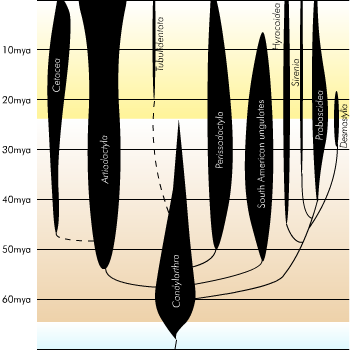|
|
Evolutionary systematics |
| Systematics |
Spindle Diagrams |
Evolutionary systematics: Spindle Diagrams

A "romerogram" (spindle diagram), showing the evolution of hoofed mammals plotting diversity (horizontal axis) against time (vertical axis), and showing the phylogentic divergence of new groups as new bubbles or balloons which increase or decrease in diversity of individuals and species through time. Diagram from Trees, Bubbles, and Hooves. |
Evolutionary systematics bubble or spindle diagrams were very common in paleontology books from the 1930s to the 70s. This type of diagram being being popularised (but not invented) by Alfred Sherwood Romer (hence the informal term, "romerogram"). It would not be an exaggeration to call Romer the most influential vertebrate paleontologist of the 20th century. Hence the influence of these diagrams on the scientific and educated lay imagination. These diagrams mapped geological time (vertical axis) against taxonomic diversity (horizontal width) and emphasised monophyletic sensu Haeckel taxa (i.e. both monophyletic and paraphyletic groups). Sometimes width did not reflect diversity but was simply artistic license. For an example of such a tree see the diagram of the evolution of the horse.
Replacing evolutionary systematics in the 1980s, the cladistic revolution (phylogenetic systematics) also placed great emphasise on tree diagrams, called cladograms, which are based either on gross morphology, molecular phylogeny, or both. Some of these diagrams can be incredibly detailed.
The cladistic revolution meant the end of the romerogram. The rejection of ancestral groups as paraphyletic and the emphasise on precise branching sequence in reconstructing phyloghenies meant that cladograms took over from spindle diagrams. The last serious use of the classic romerogram in a vertebrate paleontology textbook seems to be Carroll, 1988 (not surprisingly, Carroll studied under Romer), although Benton 2004 has revised them in modified cladistic-friendly form (rejecting ancestral groups). One big difference between evolutionary and cladistic trees is that the former include ancestral groups such as Pteridosperms, Ostracoderms, Cotylosauria, Thecodontia, and Condylartha, whereas such taxa, being paraphyletic, are forbidden in cladistic methodology, as they are defined only by shared primitive characteristics. The latter is concerned instead with sister relationships of individual species, or even, in the case of fossils, individual specimens. However, rather than being a replacement for evolutionary systematics, cladistics is a totally different system, with different methodology and taxonomic philosophy, and the present author (MAK) finds no reason why the two cannot be integrated in a larger multi-disciplinary and multi-methodology approach. For example, from an evolutionary systematic point of view, dinosaurs don't have to be called by the unweildly name of "non-avian dinosaurs", as a paraphyletic assemblage they can still be just dinosaurs (in the classic sense of the word) and yet still be ancestral to birds. MAK130323
page last modified MAK111014, edited RFVS111202
